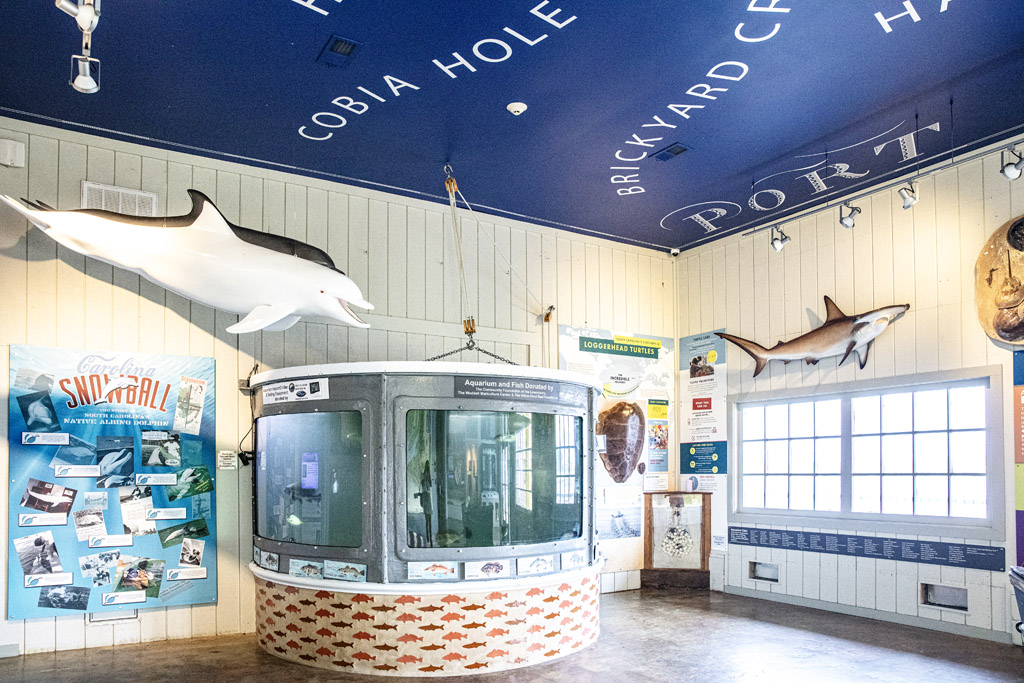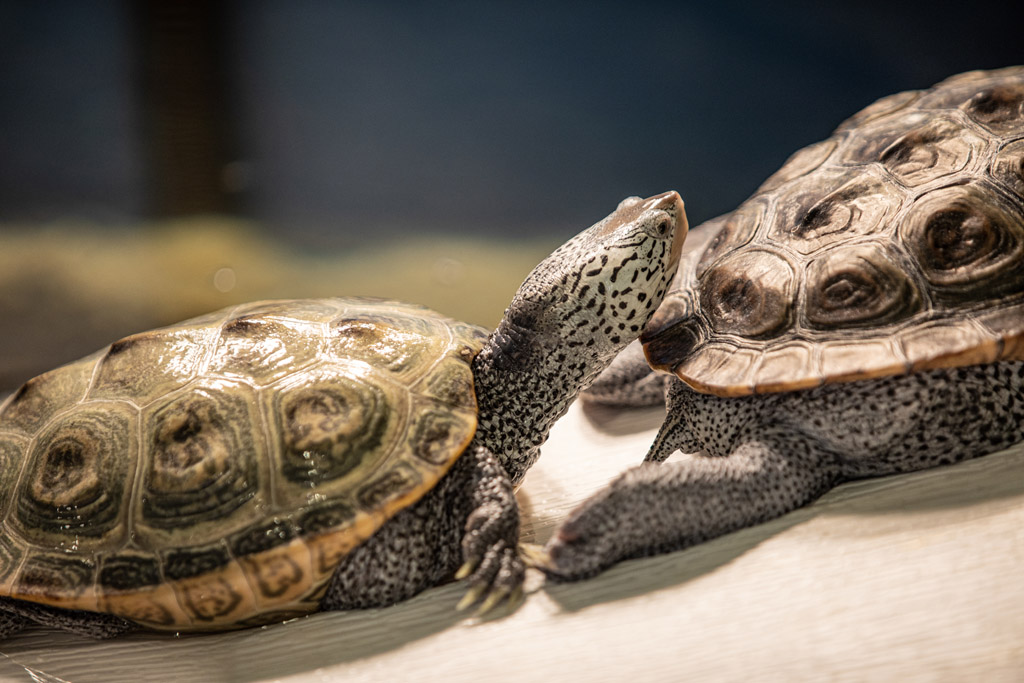The Port Royal Sound Foundation Team: Jessica Kochman, Astrid Fabian, Sarah Walbert, Chris Kehrer, Jody Hayward, Kathy Caliendo, Courtney Kimmel and Kat Armstrong
It’s impossible to talk about the dedicated work of the Port Royal Sound Foundation without delving into the unique maverick history of Beaufort County. Fifty years ago, the poorest region in the state staged an environmental coup against a major corporation long before conservation and preservation—two of the Port Royal Sound Foundation’s foundational principles—became mainstream.
While our region of South Carolina has enjoyed top honors in state wealth since the end of the twentieth century, the area was struggling post-World War II. So, when a chemical manufacturing plant was proposed for the shores of Victoria Bluff in the late-1960s, it was no wonder the rest of the state was surprised to learn that instead of embracing a business that would stimulate job growth, the impoverished community united in protest against the potential pollution of the Port Royal Sound and emerged victorious when the manufacturer cancelled its plans to build in 1971.
Ecological conservation was considered a radical ideal back then, yet over the decades, what began as a grassroots movement evolved into an environmental philosophy embraced by the community. The Port Royal Sound Foundation began as a community stewardship group. The Friends of the Rivers, formed in 2000, then changed its name to reflect its expanded mission of including all the natural, cultural, and historical resources of the Port Royal Sound system. As Jody Hayward, the foundation’s executive director notes, working towards the protection of our environment, culture, and economic health will always be an ongoing task.
“The Port Royal Sound Foundation is just one of many environmental partners in the area,” Hayward said. “Our organization concentrates on the sound while others focus on sea turtles or protecting land in the watershed. It’s important that, whether through engagements with our partners or working with the community, we continue doing what needs to be done to protect the local environment.”
With roughly 50 percent of the county covered by open water or marsh, it’s arguably certain our waters are a main contributor of Beaufort County’s drive to gain and retain the highest per capita income in the state. When you consider that the waters support our home values and the economy through trades like fishing, eco-tourism, watersports, and hospitality, it’s undeniable the water deeply influences our culture and way of life.
“We try to provide a resource to the community to educate people about the sound, engaging with them so they can experience it themselves and understand how valuable it is,” Hayward said. “As humans, we tend to take things for granted, so the foundation strives to connect visitors to the Port Royal Sound to help them appreciate the important role it plays in our local economy, ecosystem, and quality of life.”

The 3,000-gallon aquarium features a variety of saltwater fish that are native to the Port Royal Sound, including Red Drum, Sheepshead, Black Drum and more!
Hayward points out that in recent years, our area has seen rapid growth, including an influx of people moving from the north and mid-west. Helping our long-time residents and newcomers better understand what they can do in their own yards to avoid pollutants leaching into the sound has become a vitally important task for the foundation.
As a homogenous estuary, the Port Royal Sound area is distinctive in that there’s very little freshwater influence on its overall health. The rivers feeding into the area are blackwater—slow-moving tannic waters that carry no sediment—while the major waterways are tidal creeks. Because of this, impacts on the sound’s water quality are directly credited to what we as a community put into it.
“There’s no large port or big industry influence, so our watershed is unique in that what goes in it is almost entirely up to us,” Hayward said. “It’s important we’re smart about what we do in and around the sound so our beaches and waterways can continue to be open and enjoyed, and so we don’t have to invest millions and millions of dollars to keep it clean.”
“It’s a snowball effect,” Port Royal Foundation naturalist and operations coordinator, Chris Kehrer said. “With development comes an increase in impervious surfaces like parking lots and driveways which, in turn, increases runoff. Since we’re surrounded by tidal saltwater, most runoff dumps directly into our creek systems. It can take days or weeks, depending on how far inland the runoff occurs, for the system to completely flush out. Because of this, some local areas have experienced a decrease in salinity and an increase in fecal coliform and water temperature. These factors play a leading role in shellfish bed closures, among other negative effects that may occur.”
It was with this knowledge that the foundation implemented the Citizen Science Program two years ago. Currently, volunteer program participants from over 30 sites stretching from St. Helena to Hilton Head, Bluffton to Lobeco, are all collecting water samples to create a baseline that, when studied together with other contributing factors, will help monitor the health of the Port Royal Sound.

Diamondback Terrapins sun themselves under a heat lamp
“It’s a great way for community members to get involved with the Foundation,” Hayward said. “We work very closely with our partners including Dr. Daniel (Tye) Pettay at the University of South Carolina Beaufort (USCB) for the water quality portion. He engages students from the Marine Biology program on our dock, taking different water quality readings, and we love seeing the edification of the next generation of conservationists right here on our campus.”
Of course, that attitude extends well beyond university students. Through the Sharon and Dick Stewart Maritime Center—the foundation’s storefront and education center on Lemon Island—Hayward and her team have spent years developing exciting and informative programing to educate residents and visitors about our delicate ecosystem, and the community has responded with resounding support.
The children’s summer story time averages about 100 attendees per session, thanks in part to the interactive nature of the program. Young minds thrill at read-a-louds paired with craft projects or animal meet-and-greets, and it’s not uncommon to see families stick around after the event to explore all the museum has to offer. The foundation also hosts students on field trips with over 3,500 school-aged children participating in the spring 2023 season.
“We wouldn’t be here without the support of the community,” Hayward said. “Their support helps us fulfill our mission of education through the popularity of our programs which provide opportunities for folks to learn more about the diversity of the area from an environmental standpoint.”
One glance at the foundation’s website though, and it becomes clear that Hayward’s definition of community education is downright fun. “We need to preserve and protect the sound so we can all stop and enjoy everything it has to offer,” Hayward said.
Kayak and catamaran tours, hiking, and birding are all part of the foundation’s free and low-cost programming, as well as a free summer STEAM festival, annual research symposium, and weekly Tuesday Talks, where local and regional experts are brought in to talk about specific topics.
In addition to daily and weekly programs, the Port Royal Foundation is gearing up to host the ninth annual Night on the Sound on October 21 at the newly constructed, 10,000-square-foot Weezie Educational Pavilion. The event includes an online auction as well as cocktails and dinner with guest speaker Dr. Bob Hueter, who is the lead scientist with OCEARCH, a global non-profit dedicated to shark research.
As the foundation continues to grow, Hayward and her team will continue to prioritize education, research, conservation, and organizational sustainability. The past few years have seen the foundation shift to focus more on research, and Hayward says one of the most exciting things going on right now is building the research programs and getting answers about our water quality and the monitoring of the sound’s health over the next few years.
“Our main mission is to protect the sound and keep it clean and healthy. We try to do that through education and research, but it must be a total buy-in from residents and visitors alike,” she said. “We’re lucky to live here and are constantly looking for new ways to reach more people, especially new transplants. Thirty thousand cars pass by our facility every day, so trying to get more of them in the door, to encourage them to show appreciation for the sound and take ownership of it, is our ultimate goal.”
Learn more about the Port Royal Sound Foundation at their website, portroyalsoundfoundation.org. You can also visit them in person Tuesday-Saturday at the Maritime Center, located halfway between Bluffton and Beaufort where South Carolina Highway 170 crosses the Chechessee River.